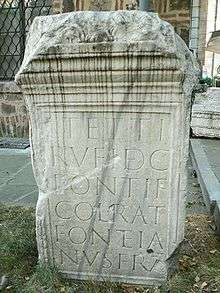Ratiaria

Coordinates: 43°48′56″N 22°54′55″E / 43.81556°N 22.91528°E

Ratiaria (or: Raetiaria, Retiaria, Reciaria, Razaria; Bulgarian: Рациария; Greek: Ραζαρία μητρόπολις; later named Colonia Ulpia Traiana Ratiaria) was a city founded by Moesi, a Daco-Thracian tribe, in 4th century BC, along the river Danube. The former Archdiocese was revived as Latin Catholic Metropolitan titular archbishopric. The city had a gold mine in the vicinity, which was exploited by the Thracians.
It is located 2 km west of present village Archar in Vidin Province, northwestern Bulgaria. The closest modern cities are Vidin (27 km. to the north west) and Lom (28 km. to the east).
History
Ratiaria was conquered by the Dacians of Burebista and later by Romans.
The earliest involvement of the Romans occurred in 75 BC, when Gaius Curio Scribonius Burbuleio, prefect of Macedonia, entered this territory to ward off Scordisci, the Dardani and Daci.
Only during the principate of Augustus, the Romans conquered the region, which was organized in the province of Moesia. In 33/34 AD a road is linked between Viminacium and Ratiaria. The city was certainly less important than the near Sirmium, Viminacium and Naissus, but its location along the Danube limes made it a key point to station a legion. Legio IV Flavia Felix was based here at least until the conquest of Dacia (101-106 AD), together with the military fleet of Classis Moesica (during Vespasian).
After the conquest of Dacia, the castrum was abandoned and became a colonia within Moesia Superior under the name Colonia Ulpia Traiana Ratiaria (107 AD), named after its founder, Emperor Trajan.
With the definitive abandonment of Dacia Traiana by Aurelian in 271, the old castra were reopened and was utilized as part of the Dacia Aureliana and later the Eastern Roman Empire.
It is unclear whether Aurelian or the Emperor Diocletian replaced Dacia Aureliana with two provinces,[2] but by 285, there were two: – Dacia Mediterranea with its capital at Serdica and Dacia Ripensis, with its capital at Ratiaria.
Later these two “Dacias” along with Dardania, Moesia Inferior and Praevalitana constituted the Diocese of Dacia.
As the capital of Dacia Ripensis, Ratiaria served both as the seat of the military governor (or dux) and as the military base for the Roman legion XIII Gemina.
A number of Roman patricians (aristocrats) lived in Ratiaria, while the nearby Bononia (today's Vidin) had established a small military unit.
- Findings from Ratiaria, exhibited in Konaka History Museum, Vidin










Ecclesiastical History
As provincial capital of Dacia Ripensis, it also was the Metropolitan archdiocese, yet was to fade.
Titular see
The archdiocese was nominally restored in 1925 as a Latin Catholic titular archbishopric of the highest (Metropolitan) rank.
The incumbent is Kurian Mathew Vayalunkal, having the following previous incumbents:
- Gustave-Charles-Marie Mutel (민 아우구스티노), Paris Foreign Missions Society (M.E.P.) (1926.01.11 – 1933.01.22)
- Andrew Killian (1933.07.11 – 1934.11.05)
- Anselm Edward John Kenealy, Capuchin Franciscans (O.F.M. Cap.) (1936.01.13 – 1943.12.08)
- Nikolay Avtonomov (1945.10.06 – 1979.08.13)
- Marian Oles (1987.11.28 – 2005.05.24).
- Kurian Mathew Vayalunkal (2016.05.03 – ).
Famous locals
- Palladius of Ratiaria, late 4th century Arian Christian theologian
See also
References
- ↑ AE 1911, 214; AE 1919, 81.
- ↑ Bury, p. 135. The date must be A.D. 283, and it is obvious that Aurelian set up the boundary stones, one of which Gaianus restored. There were, then, two Dacias when Diocletian came to the throne and, therefore, Mr. Fillow has inferred that we should read in our List: Dacia <Dacia>, that is presumably Dacia Ripensis and Dacia Mediterranea. Aurelian's Dacia mediterranea might have included Dardania, and Dardania, Mr. Fillow thinks, was split off as a distinct province by Diocletian.
Sources and External links
| Wikimedia Commons has media related to Ratiaria. |
- Bulgarian Archaeological Association - Excavations at Ratiaria
- GigaCatholic, with titular incumbent biography links
- Archaeological excavations of Ratiaria by the village of Archar
- Sarcophagus Ratiaria (Image)
